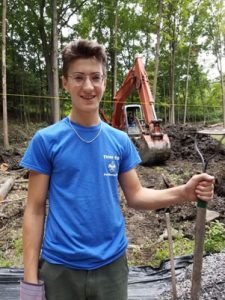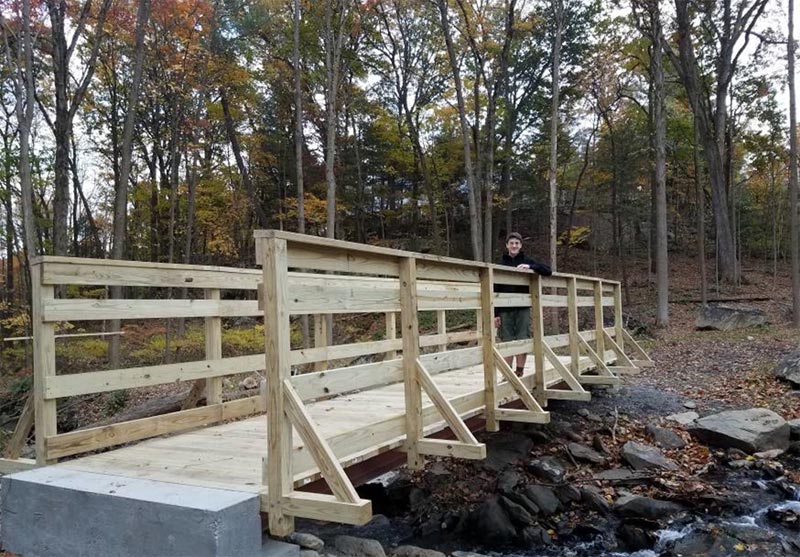A Magical Spot
Summer 2019
Highland has a few magical spots which remain unsullied by time’s aggressive fingers.
If you walk down Mile Hill Road, for instance, the incline becomes steep and you’ll eventually come to the crux of a “y.” At this point, the Twaalfskill Creek, which has raced down Mile Hill with you, gushing with the spring thaw, cuts under the road and pops out on the other side. It unites farther on with the majestic Hudson which is just barely visible downslope as it wends its way southward. Also, at this point, another spoke of the “y”, mysteriously called Ransom Road, juts up sharply to your right. Behind you is a spot which Aunt Dot Gruner (former town of Lloyd historian) identified many years ago as “Hobo Springs” which reputedly marks where destitute rail-hoppers came to camp during the Great Depression. Above your head, the black iron trestles from the 1889 railroad bridge (now known as the Walkway Over the Hudson) loom through a canopy of leaves.

Casey Rosen rakes the gravel level while Mr. Decker operates the backhoe.
Now, thanks to Highland High School senior Casey Rosen, this spot is permanently fixed as part of the Hudson Valley Rail Trail system which connects the upper Walkway path with the Hudson River itself at Bob Shepherd Highland Landing and also with the Franny Reese trails accessed farther down on Oaks Road. Through his leadership effort and community service, Rosen’s Eagle Scout Project came to fruition as a wooden footbridge spanning the Twaalfskill and linking these locations.
Some Eagle Scout Projects, Rosen explained, can be more cerebral, like writing a book, but for his part, he “just wanted to build something.”
“Lucky for me,” Rosen explained, “in my troop, one of the Eagle Scout Board members, Mr. [Peter] Bellizzi, is the Hudson Valley Rail Trail president and he helped me invent this new project–the bridge,” Rosen says he immediately liked the idea of designing and building a bridge that would extend the trail system.
For the design, Rosen researched and designed plans on his own and then consulted the expertise of Highland resident and engineer Paul Krystek who is also an Eagle Scout advisor. “He kind of told me what was wrong and then we fixed it and it ended up being, well, overkill,” he laughed and then proudly added, “but it works. I like that it can carry a car.”
Rail Trail president and Eagle Scout advisor Pete Bellizzi was impressed with Rosen’s leadership, his hard work, and his detail-oriented ethic: “His project proposal is 208 pages long. You would be able to pick up his Eagle Scout book and start working on this bridge where someone left off. You would know what materials, what labor, and where.”
The ambitious project took Rosen nine months to complete, which included seven months of planning and two months of building. The bridge cost about $1200 and Rosen was able to get donations – from excavators, lumber, and steel, to steel fabricator work–which sped the project along.

Casey Rosen standing on his finished bridge.
The bridge is 30 feet long and four feet over the Twaalfskill. This is to account for flooding and was determined, Bellizzi explained by reviewing the 100-year flood marks, where water had worn through stone. This water volume determined the bridge’s height and length.
As for challenges other than engineering, Rosen mentioned having to “step out of his shell”and ask for donations. “It’s a lot harder than you would think to go around knocking on doors to ask for donations,” he reflected.
Also, the weather sometimes presented an obstacle when site visits and work crews had to be postponed due to rain. Because that extended the time and that he ran out of wood, he had to go back and ask for more donations to purchase the needed wood. At one point, someone had the audacity to steal the purchased wood from the job site. Rosen, luckily, had enough in his budget to cover the re-purchase.

Casey Rosen and his dad Ben removing the frames from the cured concrete.
Rosen prefers to focus on how community service brings people together and creates a lasting impression. “For me,” Rosen reflected, “it’s important because I live here and I can benefit from it, but I think everyone can benefit from it.”
Bellizzi agrees, proud that Rosen was able to create a connection from Bob Shephard Highland Landing Park up to Johnson-Iorio-DiLorenzo Park at the Franklin D. Roosevelt bridge abutment.
When it is hot out, he added, trail walkers and cyclists can cool off by heading under the canopy of trees. Bellizzi has seen an uptick in tourism: “A lot of boats from Marist (College) dock down at Shephard Landing and come up to the Walkway rail trail. [This bridge] makes it a little safer.”
The grand opening of the bridge occurred this past December and it is officially ready for you to enjoy a brisk Summer walk through this gorgeous locale. As Bellizzi described, “It’s soothing down there. It’s away from traffic and you get away, into nature.”
Images courtesy of the Rosen family.
